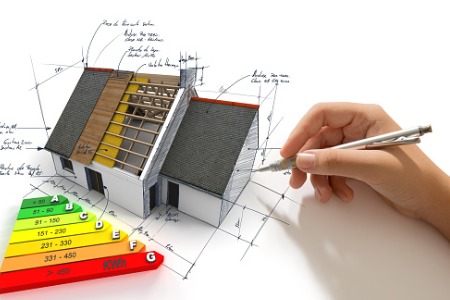
You may be looking for ways to reduce your impact on the environment, and if you’re looking to build a home, there are plenty of reasons to build sustainable. From using renewable materials to installing solar panels and even building smaller, here’s what you should keep in mind if you’re looking to build your home the eco-friendly way.
Build a smaller home
There are many benefits of building a small home, from a lower building cost to less maintenance and even better energy efficiency. You could build the largest, most eco-friendly home, but still a small home built with the same eco-friendly home design will have the least environmental impact. Whether you’re interested in living in a tiny home or you just want your home design to be space-efficient, there are so many ways to build a smaller, smarter home so that you can still live comfortably while reducing your footprint.
Plan for solar panels
Use the sun as an energy source as much as you can. Installing solar panels on your rooftop is a lot easier if you plan to have a solar-powered home from the very beginning of the building process. Solar panels are an investment, but once they’re installed, they are an excellent source of clean, low-cost energy. As a home builder, you have the opportunity to plan for solar panels from the beginning, meaning you can position them to perfection and optimize your energy use from the moment they are installed.
Use sustainable materials
One of the easiest ways to build an eco-friendly home is by using sustainable materials. Choose a wood supplier who follows sustainable planting practices, and install flooring made renewable materials like bamboo, cork, and linoleum. From the roof and walls to the floor and insulation and even the cabinets and counter-tops, every element of your home can be built using greener, more sustainable materials, thereby reducing your environmental impact from the moment you break ground.
Ensure proper insulation
Your insulation should not only be sourced from sustainable materials, but also should be proper and effective. The better your home insulation is, the cooler your home will stay in the summer and the warmer it will stay in the winter. This means that better insulation reduces energy consumption season after season, as you’re less likely to run your air conditioner in the hotter months or turn up the thermostat in the colder months. Heating and cooling make up around 50 percent of the average household’s energy consumption, so why not reduce your energy bill while also reducing your environmental footprint simultaneously?
Water harvesting and conservation
Have you ever considered harvesting rainwater? Like solar panels, a rainwater harvesting system can be an investment upfront, but it will surely save you money in the long run. After a storm, a proper rainwater harvesting system collects water and stores it to be used for plumbing or sprinkler systems. Additionally, you can conserve water by equipping your home with fixtures and appliances that work to lessen your water consumption, like low-flow faucets and toilets and Energy Star washers and dishwashers.
For eco-friendly home tips like these and more, subscribe to our newsletter!
This post is intended for informational purposes only and should not be taken as professional advice. The point of view and opinions expressed in this post are those of the author and do not necessarily reflect the position of Realty Executives International. This post was written by Bailee Abell. Bailee Abell is a writer born and raised in California. A graduate of University of California, Santa Barbara, she loves reading classic literature, sipping warm beverages, and visiting theme parks every chance she gets. Find her at baileeabell.com.
